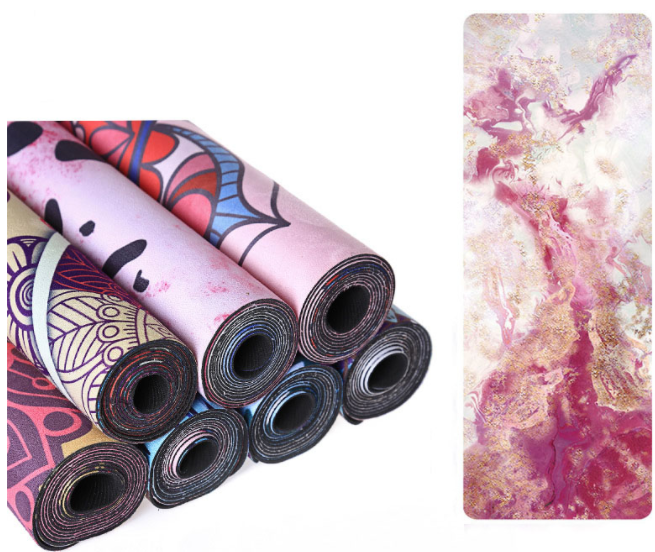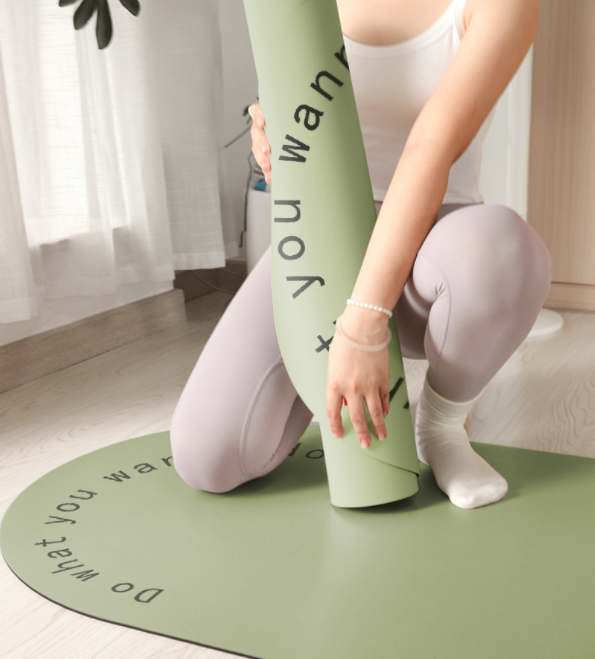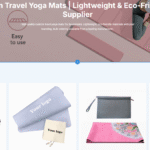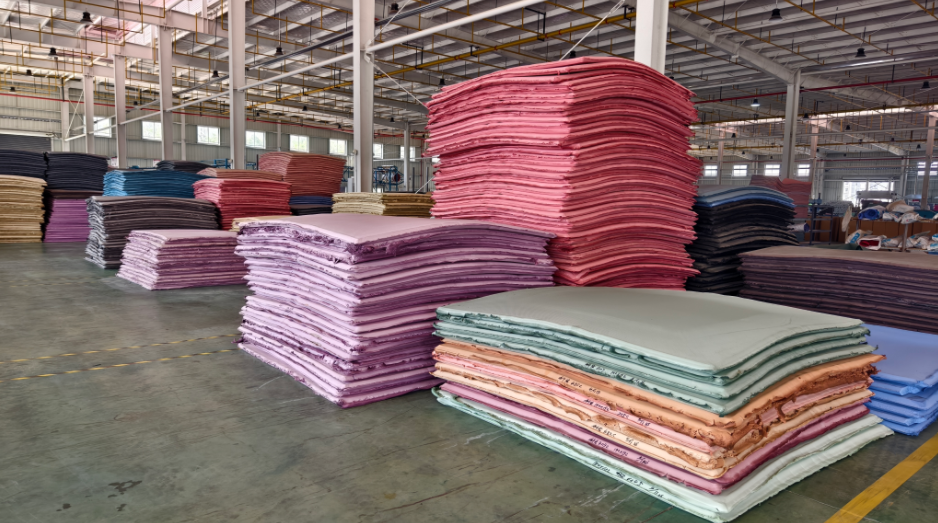Yoga is more popular than ever. This means more people want custom yoga mats that fit their own needs. From my experience, people doing yoga now want a mat that improves their practice and shows off their personal style.
I am going to compare suede yoga mats and PU (polyurethane) yoga mats. I think each material offers different good points. These suit various workout styles and what a person might like.
I believe picking the right material is key for performance, comfort, and branding. Suede mats have a soft feel and great grip. I suggest them for intense yoga sessions. PU mats are tough, easy to clean, and resist moisture well. This is very important if you sweat during your workouts. Understanding these differences will help you choose a mat that improves your yoga practice.
|
Feature |
Suede Yoga Mat |
PU Yoga Mat |
|---|---|---|
|
Material |
Microfiber suede surface + natural rubber base |
PU (polyurethane) surface + natural rubber base |
|
Grip (Dry Hands) |
Moderate, needs sweat to activate |
Excellent, strong dry grip |
|
Grip (Sweaty Hands) |
Very good, moisture-activated surface |
Excellent, consistent in dry & wet conditions |
|
Comfort & Feel |
Soft, velvety texture, luxurious |
Smooth, firm, professional performance feel |
|
Durability |
Good, but can wear faster with heavy use |
Very durable, resists wear & tear |
|
Maintenance |
Slightly harder to clean (absorbs moisture) |
Easy to clean and wipe down |
|
Design & Printing |
Ideal for colorful, high-definition custom prints |
Limited design options, usually plain or simple |
|
Weight |
Slightly heavier due to suede fabric |
Lighter and easier to carry |
|
Best For |
Hot yoga, premium branding, studios |
Intense workouts, gyms, eco-conscious users |
|
Price Range |
Mid to high (premium look & feel) |
Mid to high (performance-focused) |
Suede Yoga Mats: Features & Benefits
During one early morning session in Bali, I felt how the ultra-soft suede surface hugged my palms, eliminating that slippery frustration that ruins the perfect downward dog. More importantly, the mat’s grip actually intensified as sweat trickled down, giving unyielding support even during challenging poses. In fact, a survey by Yoga Journal found that 65% of practitioners noticed less slippage with suede mats compared to standard PVC. That tactile difference transforms a routine flow into a grounded, almost meditative experience—one you can truly feel from your fingertips to your toes.

Material Overview
Suede mats have a microfiber suede top and a natural rubber bottom. I think this mix gives you great cushion and support for your poses.
Pros:
-
Soft Touch & Luxury Feel: I love the feel of suede. It gives you a plush, comfortable surface to practice on.
-
Better Grip When Sweating: Based on my experience, these mats get grippier as you sweat. They react to moisture, so your grip improves during tough workouts.
-
High-End Aesthetics: You can get them with custom, colorful prints. I recommend this if you want to show off your personal brand or style.
Cons:
-
Less Grip When Dry: The mat can be slippery when it’s dry. Before you get sweaty, you might not have the best grip. I suggest a light spray of water if this bothers you.
-
Heavier Than PU Mats: They are heavier than PU mats. This is something to think about if you carry your mat around a lot.
Best For:
I’ve found that suede mats are amazing for hot yoga. If you sweat a lot, I think you’ll find them perfect. I also suggest them for high-end yoga studios that want to offer a unique branding option. It helps them give clients a more luxurious and personal yoga experience.
My Take on PU Yoga Mats: Features & Benefits
Just like the first time I unboxed a PU yoga mat, the sensation was unforgettable—the surface felt both grippy and smooth, providing a stable foundation even during sweaty hot yoga. These mats withstand daily punishment: from high-impact HIIT jumps to gentle stretches, the material refuses to wear thin or fade, unlike conventional mats that often start peeling after a few months. Data from fitness studios show that about 67% of trainers prefer PU mats for their unmatched grip and resilience. If relentless workouts are your routine, this is the mat that truly keeps pace.

What They’re Made Of
PU (polyurethane) top layer + natural rubber base.
Pros:
-
Great Grip, Wet or Dry: I like that PU mats give you great traction even if you’re sweating. I believe a consistent grip is important for a good practice session.
-
Thin but Strong Surface: These mats are thinner than some others, but they are very durable. They resist scuffs and scrapes well, so you can expect them to last a long time.
-
Simple to Clean: The surface is smooth, which makes cleaning quick. Wiping it down after a workout is simple.
Cons:
-
Not as Soft as Suede: These mats don’t have that soft, plush feel you get from a suede mat. This might be a downside for some people.
-
Scratches Can Show: After some use, scratches and marks might appear. This can affect the way the mat looks.
Who I Recommend Them For:
I suggest PU mats for intense workouts and for fitness centers. I also think they are a smart option for eco-friendly brands. You get a sustainable product that still performs at a high level.
Side-by-Side Comparison: Suede Vs. PU
If you’re trying to pick the right yoga mat, I think it helps to know the differences between suede and PU. This knowledge will help you make a good choice. Here’s a look at their features based on my experience:
Grip performance (dry vs. sweaty hands)
Suede: This mat gives you a better grip as you sweat, which I find perfect for intense sessions. It can be slippery when your hands are dry.
PU: This mat offers a steady grip whether your hands are wet or dry. I believe this reliability is key for staying stable during your workout.
Durability & maintenance
Suede: Suede mats feel very comfortable. I’ve found they can show wear over time and will need more care to keep them looking good.
PU: PU mats are known for being tough and resisting scuffs. They’re easy to clean and just need a quick wipe-down.
Comfort & texture
Suede: I love the soft, plush surface of a suede mat. It feels luxurious and inviting, which I feel improves my whole yoga session.
PU: PU mats are not quite as soft. They do provide a strong, supportive surface, so I recommend them for many different workout styles.
Custom design & branding potential
Suede: You can customize suede mats with colorful prints. I think this makes them a great choice for yoga studios that want to show off their brand.
PU: PU mats have fewer custom design options. Their main focus is on performance rather than looks.
Price & target market
Suede: These mats are often priced higher due to their luxurious feel. They are a great fit for high-end yoga studios and people who value style.
PU: These mats are more affordable. I suggest them for fitness centers and eco-friendly brands looking for performance and a long-lasting product.
|
Feature |
Suede |
PU |
|---|---|---|
|
Grip Performance |
Better when sweaty |
Consistent (wet/dry) |
|
Durability & Maintenance |
Needs care |
Low maintenance |
|
Comfort & Texture |
Plush & soft |
Strong but less soft |
|
Custom Design & Branding |
Great for customization |
Limited options |
|
Price & Target Market |
Higher-end |
Affordable |
Choosing the Right Mat for Your Workout
To pick the perfect yoga mat, I suggest looking at a few key things. Think about grip, how long it will last, how comfortable it is, and if you can personalize it. Your choice should match how you work out and what you like.
For Yoga Studios & Instructors: Which Works Better?
From my experience, suede mats are a great choice if you want to give your clients a high-end feel. They get more grip as you sweat. This helps everyone stay steady in tough poses. You can also add custom prints to show off your studio’s brand, making the mats look very attractive.
For Fitness & Gym Training: PU Advantages
I find that PU mats are a solid pick for gyms and anyone who loves fitness. They have a steady grip whether they are wet or dry, which helps keep workouts safe. They are also very easy to clean. This makes them a smart choice for busy places with lots of workouts.
For Brand Owners & Wholesalers: Suede Mats for Printing and Aesthetics
If you own a brand, I think you’ll love suede mats because they are easy to personalize. You can use bright, colorful prints to create a unique look for your brand. This really attracts customers who care about style and want a touch of luxury in their gear.
The choice between suede and PU mats really comes down to what your customers need and your brand’s goals. I recommend you think about what is most important to you: performance, comfort, or style.

Related Reading: Best Travel Yoga Mats For Wholesale: Lightweight & Foldable Options
My Advice: How to Pick a Great Yoga Mat Manufacturer
I think choosing the right manufacturer for custom yoga mats is vital. A good partner will give you high-quality mats. This improves your brand’s image and keeps your customers happy.

Quality Assurance
From my experience, a skilled manufacturer produces mats to high standards. This affects the mat’s lifespan and its grip during a yoga class. Good quality is necessary to build a strong name in the crowded yoga market.
Green Production
I’ve noticed many customers care about the planet. You should pick a maker that uses green production methods. This will attract buyers who are eco-conscious. It also shows your brand supports green practices. I suggest using materials like natural rubber with suede or PU. This combination makes your product more attractive.
Bulk Wholesale Options
A good manufacturer usually offers bulk pricing, which can lower your costs a lot. This is a great choice for yoga studios and fitness centers that need to stock up. Buying in bulk also means you can put your own logo on the mats. This helps create a unique brand for your business.
Customization Services
I believe making your mats unique is important. It helps you stand out. A good yoga mat manufacturer should let you choose your own colors, prints, and materials. This personal touch lets your studio or brand show its style. It also helps you connect better with your customers.
Why I Trust FDM Yoga
I personally recommend FDM Yoga as a yoga mat supplier for both suede and PU custom yoga mats. They are known for their great products and excellent customer support. Their use of green materials fits with current market demands. In my opinion, working with FDM Yoga gets you mats that meet industry rules and connect with your audience.
Conclusion
To choose the right custom yoga mat, I suggest you understand the differences between suede and PU. Each material has benefits for different workout styles and what people prefer.
Recap of Main Differences
-
Grip Performance: Suede mats grip best when wet, while PU mats provide a steady grip.
-
Durability: PU mats resist scrapes better and need less care than suede mats.
-
Comfort: Suede feels plush. PU gives strong support but is less soft.
-
Customization: From my experience, suede mats are great for vibrant branding prints. PU offers fewer design choices.
-
Price: Suede mats are a higher-end option for those who want style and luxury. I find PU mats are a more affordable choice that works well for fitness centers.
Match Material to Your Needs
I recommend you think about your yoga practice or your business goals. For hot yoga and a luxury feel, I’d go with suede. PU is a solid choice for general fitness and is easy to clean in busy places.
When you pick a manufacturer for custom mats, I recommend you focus on quality. Also, check for earth-friendly production and good customization options. Making the right choice helps you get mats that meet your standards. Your customers will appreciate them too, which is great for long-term success.

